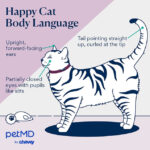Garlic, a staple in kitchens worldwide, adds a savory depth to countless human dishes. From roasted cloves to garlic powder, its aromatic presence is undeniable. However, while humans relish the taste, garlic poses a significant threat to our feline companions. If you are a cat owner, understanding the dangers of garlic for “garlic cats” is crucial for your pet’s safety.
Why is Garlic Toxic to Cats?
Whether raw, cooked, or powdered, garlic is toxic to cats and should never be a part of their diet. Garlic, along with onions, chives, and leeks, belongs to the Allium genus, and all members of this family are harmful to cats. The culprit behind garlic’s toxicity is a compound called sodium n-propyl thiosulfate.
This toxic agent damages a cat’s red blood cells. It makes these vital cells fragile, leading to their premature breakdown and destruction, a process known as hemolysis. Hemolysis leads to anemia, a dangerous condition where the cat’s body doesn’t receive enough oxygen. Signs of this can include discolored urine, appearing red or brown. Severe anemia can lead to organ failure and even be fatal if left untreated. Therefore, garlic poisoning in cats is a serious medical emergency.
How Much Garlic Is Too Much for Cats?
Garlic is significantly more potent than onions, making it especially dangerous for cats. Due to their smaller size and sensitivity, even small amounts of garlic can cause severe toxicity in cats.
Consider this: for an average-sized cat weighing around 10-12 pounds, less than one small clove of garlic, approximately 4-7 grams, can be enough to trigger severe garlic poisoning. This translates to less than half a teaspoon of minced garlic or even less than an eighth of a teaspoon of garlic powder being potentially toxic.
It’s often difficult to accurately measure the garlic content in cooked meals or pre-packaged foods. Therefore, the safest approach is to assume any amount of garlic is dangerous. If you suspect your cat has ingested any garlic-containing food, immediate veterinary attention is vital.
Recognizing Garlic Poisoning in Cats: Symptoms to Watch For
If your cat has eaten garlic, symptoms of garlic poisoning can appear within 24 hours, though they might sometimes be delayed for a few days. Being vigilant and recognizing these signs is crucial for prompt action. Symptoms to watch out for include:
- Vomiting: Your cat may throw up as their body reacts to the toxin.
- Diarrhea: Digestive upset is a common sign.
- Decreased or Loss of Appetite: Your cat may refuse to eat due to feeling unwell.
- Abdominal Pain: Your cat might show signs of discomfort or tenderness in their belly.
- Pale Gums: Healthy gums are pink; garlic poisoning can cause them to become pale pink, white, or pale yellow due to anemia.
- Lethargy and Weakness: Your cat may appear unusually tired, sluggish, or weak.
- Discolored Urine: Urine may be red or brown due to the breakdown of red blood cells.
- Increased Respiratory Rate: Your cat might breathe faster as their body tries to compensate for reduced oxygen.
- Increased Heart Rate: Similarly, the heart might beat faster to circulate oxygen more quickly.
- Collapse: In severe cases, your cat may collapse due to weakness and lack of oxygen.
My Cat Ate Garlic – What Should I Do?
Even if you only suspect your cat has eaten a small amount of garlic, it’s essential to act quickly. Garlic poisoning is a serious condition, and prompt veterinary care can significantly improve your cat’s chances of recovery.
If your cat ingests any garlic, take them to the veterinarian immediately. Do not wait for symptoms to appear. Early intervention is crucial in managing garlic toxicity.
When you go to the vet, try to estimate how much garlic your cat might have consumed and bring any packaging of the garlic-containing product if possible. This information can help your veterinarian assess the situation and plan the appropriate treatment.
You can also contact your veterinarian, the Pet Poison Helpline at 855-764-7661, or the ASPCA Animal Poison Control Center at 888-426-4435 for guidance while en route to the vet or to determine the urgency of the situation.
Crucially, do not attempt to induce vomiting at home. Inducing vomiting in cats can be risky and should only be done by a veterinarian. Your priority should be to get your cat to professional veterinary care as quickly as possible.
Diagnosing and Treating Garlic Poisoning in Cats
Diagnosing garlic poisoning typically involves a combination of factors. Your veterinarian will consider your cat’s history, the clinical signs they are exhibiting, and a microscopic examination of a blood sample. The toxic compound in garlic causes specific structural damage to red blood cells that can be identified under a microscope.
If your cat has ingested garlic within the last couple of hours, your vet may attempt to induce vomiting at the clinic to remove some of the garlic from their system. Following this, or if inducing vomiting is not feasible, activated charcoal might be administered. Activated charcoal works by binding to any remaining toxin in the stomach and preventing further absorption into the bloodstream.
In more severe cases, hospitalization may be necessary. Treatment can include intravenous (IV) fluids to support hydration and kidney function, and in critical situations, a blood transfusion might be required to combat severe anemia.
The prognosis for cats with garlic poisoning depends on the amount of garlic ingested and how quickly treatment is initiated. With prompt and appropriate veterinary care, many cats who have ingested small amounts of garlic recover fully without long-term complications. However, severe garlic poisoning can be fatal, particularly without treatment.
The best approach to protect your feline friend is prevention. Never knowingly feed your cat garlic or foods containing garlic, garlic powder, or other Allium vegetables. By being informed and vigilant, you can keep your cat safe from the dangers of garlic toxicity.
References
Peterson, Michael E. Small Animal Toxicology. 3rd ed. Elsevier Saunders; 2001.
Hovda, Lynn, et al. Blackwell’s Five-Minute Veterinary Consult Clinical Companion: Small Animal Toxicology. 2nd ed. John Wiley & Sons; 2016.


